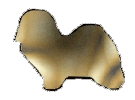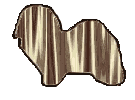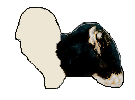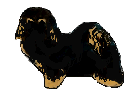
Dark/light patterns
Remember that dogs have two kinds of pigment possible in their coats; dark pigment called "Eumelanin" and light pigment called "Phaeomelanin". The colours below all display both dark and light coat pigment in varying proportions. They are a mix of eumelanin and phaeomelanin. Seeing as each example shows more than one colour, these can better be understood as mixed-colour patterns rather than single colours.
Dark/Light patterns
These patterns all contain a blend of both dark and light coat colours in varying proportions and in different layouts. Who would have thought there could be so many different combinations of dark and light? No wonder we get confused.
Note that the light colours in each of these combinations are cream, gold, or red, and not white. Coloured coats broken with white markings will be discussed a little further on in the white markings page.
All these dark/light blended coats are possible in either black or brown. Brown may be the dark colour in all the same variations, markings, and patterns as black, so there may be Chocolate Sables, Chocolate Brindles, Chocolate and Tan etc. See Gallery 9 for examples.
Photos:
Photo examples can be found in Gallery 2 (sable), Gallery 6 (brindle), Gallery 4 (point) and Gallery 10 (brown based patterns)
 SABLE: Sable coats are distinguished by darker tipping on a lighter coloured underfur or a dark overlay on a lighter base coat, similar to the colouring of a Shetland sheep dog. The amount of tipping may be heavy or light. The underfur can be red, gold, or cream. Tipping may be black, charcoal, silver or darker shades of brown. If the tipping is cut off, generally it will not return as deeply.
SABLE: Sable coats are distinguished by darker tipping on a lighter coloured underfur or a dark overlay on a lighter base coat, similar to the colouring of a Shetland sheep dog. The amount of tipping may be heavy or light. The underfur can be red, gold, or cream. Tipping may be black, charcoal, silver or darker shades of brown. If the tipping is cut off, generally it will not return as deeply.
Areas with the most concentration of dark hairs are usually the ears, tail, and along the spine. Some Sable dogs lighten dramatically as they mature almost to pale ivory or off-white leaving just subtle shadings and highlights of colour. A true Sable will always retain some dark tipping (even if just a few hairs) on the ears and/or tail or have some individual dark hairs long the spine. See photos in Gallery 2.
 BRINDLE: Brindle combinations give dark bands of black or brown, more or less regular, tiger striped on a lighter background of any shade from cream, champagne, tan, gold, or red. Before the coat grows out, a brindle Havanese puppy would have a streaked coat appearance similar to that seen on brindle coats of the Boston Terrier or Great Dane).
BRINDLE: Brindle combinations give dark bands of black or brown, more or less regular, tiger striped on a lighter background of any shade from cream, champagne, tan, gold, or red. Before the coat grows out, a brindle Havanese puppy would have a streaked coat appearance similar to that seen on brindle coats of the Boston Terrier or Great Dane).
Tiger stripes are apparent at birth and may run all over the body from head to tail tip in splotches, streaks, or stripes. Stripes may be bold and distinct or faint and subtle. Brindle dogs often have a dark mask on the face and at birth, may have black ears, paws and tail as well as a dark dorsal stripe. New born Brindle puppies will have a definite striped or mottled appearance. As the coat grows out, the pattern is lost , leading to much confusion about Brindles. See photos in Gallery 7.
 AGOUTI: sometimes called WILD - Each individual hair is banded in three to five, or more, rings of alternating dark/light colour similar to what is seen in the fur of wild animals like the rabbit or wolf. In dogs, Agouti coats are found on the Pomeranian, Keeshond, Siberian Husky, and other Spitz breeds. The agouti banding patterning is distinct and unusual. ... Read more about it
AGOUTI: sometimes called WILD - Each individual hair is banded in three to five, or more, rings of alternating dark/light colour similar to what is seen in the fur of wild animals like the rabbit or wolf. In dogs, Agouti coats are found on the Pomeranian, Keeshond, Siberian Husky, and other Spitz breeds. The agouti banding patterning is distinct and unusual. ... Read more about it
Controversy exists whether Agouti is a separate pattern of its own or a variation of Brindle or Sable. In other breeds, Agouti is genetically different from both. The same is likely true of Havanese. Not only an individual pattern, the term "agouti" is also the broader name of a gene series which encompasses many patterns. See the inheritance page for more information.
 SADDLE: Generally born Black and Tan but may also be other colours. As the puppy matures, the coat colour starts fading from the front towards the rear. The colour fade stops around the area of the withers, leaving the head and forequarters lighter coloured and the body and hindquarters darker coloured. This pattern is similar in appearance to a Yorkshire terrier or Silky terrier.
SADDLE: Generally born Black and Tan but may also be other colours. As the puppy matures, the coat colour starts fading from the front towards the rear. The colour fade stops around the area of the withers, leaving the head and forequarters lighter coloured and the body and hindquarters darker coloured. This pattern is similar in appearance to a Yorkshire terrier or Silky terrier.
See photos of Saddle colour development on Gallery?"
 POINT: Predominantly dark coat overlaid with a lighter colour point pattern. The most common background coat colour is black but it may also be Sable, Silver, or Chocolate. Colour points are laid out in a specific pattern with lighter markings appearing on the muzzle, eyebrows, inner ears, cheeks, legs, chest and vent (similar to the markings seen on a Doberman or Rottweiler).
POINT: Predominantly dark coat overlaid with a lighter colour point pattern. The most common background coat colour is black but it may also be Sable, Silver, or Chocolate. Colour points are laid out in a specific pattern with lighter markings appearing on the muzzle, eyebrows, inner ears, cheeks, legs, chest and vent (similar to the markings seen on a Doberman or Rottweiler).
Colour points may be solid or brindled and any shade of tan or gold (Tan Point) or silver (Silver Point). Points often lighten to silvered pearl or creamy white as the dog matures. See photos in Gallery 4